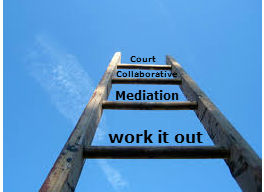 PRINT CHECK LIST OUT HERE
PRINT CHECK LIST OUT HERE
POST DIVORCE CHECKLIST
Too often when a divorce is completed the parties are handed a Final Judgment of Dissolution and a copy of their Marital Settlement Agreement and nothing more. After many months of being under the care of professional counsel, financial advisers, mediators and mental health experts, the parties suddenly are left on their own to move on with their lives. In order to help with the transition, here is a list of items that should be considered after the divorce is final. For my professional colleagues, please print out the list from the link above and hand out to your clients. If you have other items that should be included on the list, please let me know and I will update on this site.
The first thing you should do at the conclusion of your divorce process is to obtain several Certified Copies of the Final Judgment. Review all of the paperwork carefully with your counsel to ensure you understand what you must complete under the Settlement Agreement and / or Final Judgment. While the list below is comprehensive, there may be additional items required in your decree that are not listed below.
Personal Care
- If you are feeling a sense of loss, grief or depression seek professional assistance or a support group to take care of yourself
- Take some time for a little personal self-care. Have a massage, visit a spa (yes even the guys enjoy this), take a short vacation or weekend break.
Financial Accounts
- Close all joint checking & savings accounts as soon as all outstanding checks and automatic payments have cleared the bank
- Open new checking & savings accounts
- Update automatic payments taken from your accounts with new account information
- Change named beneficiaries of retirement accounts & life insurance policies
- Create new Estate Plan (Will, Trust, Health Care Surrogate, Living Will & Power of Attorney)
- Ensure all prior Powers’ of Attorney are revoked in writing
- If Qualified Domestic Relations Order (QDRO) is required by Final Judgment, follow-up with Plan Administrator to ensure they are notified of the divorce and the QDRO is completed
- If there is to be a transfer of IRA funds the receiving spouse must open a qualified IRA to receive the funds and the distributing spouse must notify the financial institution to initiate the transfer
- Close all joint credit card accounts
- Change all passwords for online account access
- Request a final bill from your legal counsel and ensure it is paid
- Obtain a copy of your credit report 30 days after the final judgment to ensure that all joint accounts have been closed
- Close joint safe-deposit boxes & open new one in individual name
Insurance
- Secure COBRA or other health insurance / notify employer of divorce if health insurance provided through employer
- Update auto, home owner & flood insurance records / secure new insurance
- Change beneficiaries on all life insurance, disability or other insurance policies
PROPERTY & ASSET RECORDS
- Sign documents to retitle cars, campers, boats, planes and other vehicles into individual names and file new title with DMV or other agency
- Record deeds transferring title to real property
- Notify utility companies if new name on account
- Ensure any funds held in escrow are transferred or returned (security deposits on rental property, utility deposits)
- Notify the Post Office of change of address and mail forwarding
- Arrange for the transfer of any personal property that must be distributed as soon as possible
PARENTING ISSUES
- Update school records with name and address of both parents
- Update medical records with name and address of both parents
- Sign up for Our Family Wizard (http://www.ourfamilywizard.com/ofw/) or other program to manage parenting contact, children’s schedules, medical re-imbursement payments, etc.
- Set up direct deposit or Income Withholding Order for child support
NAME CHANGE
- Update Social Security Administration
- Update driver’s license & auto registration with DMV
- Update bank and credit card records
- Update employment records
- Update insurance records (health, life, disability, auto, homeowners)
- Update IRS records
- Professional licenses
- Update Passport
TAXES
- Obtain IRS Publication 504, “Divorced or Separated Individuals” for information about filing status, exemptions, alimony, QDROs, etc.
- Change your tax withholding allowances with your employer
- Use the IRS withholding calculator to determine your new withholdings (http://www.irs.gov/Individuals/IRS-Withholding-Calculator)
- If you are receiving alimony or self-employed determine if estimated quarterly payments will be necessary.
- Execute IRS form 8332, Transfer of Dependency Exemption, if required under terms of the Settlement Agreement / Final Judgment
Sharon O’Day, Esq., O’Day Resolutions, 2014
Florida Board Certified in Marital & Family Law, Supreme Court Certified Family & Civil Mediator
Collaborative Attorney

